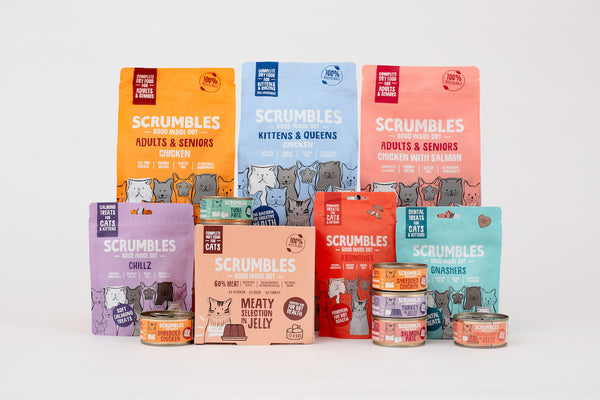Short | Scurriers | Controversial. Named after the short inhabitants of Munchkin City in the Wizard of Oz, the Munchkin cat is a pint-sized floof. However for what they lack in size they most certainly make up for in cuteness. Although recognised by TICA as a pedigree breed, they are yet to gain the same from the GCCF due to controversies surrounding the health of these cats and the ethics of their breeding. Let’s take a closer look.

MUNCHKIN CAT BASICS
Average Lifespan: 9 - 14 years
Average Weight: 2.5 - 5kg
Coat Length: Short - Long
Colouring: All colours and combinations
Shedding: Moderate
WHAT IS THE ANCESTRY OF THE MUNCHKIN CAT?
Cats with teeny-tiny limbs have been around since at least the 1940s but it wasn’t until the 80s that the breed found its legs (pardon the pun). In 1983 the American cat breeder Sandra Hockenedel found a pregnant short-legged cat which she named Blackberry. This unique floof went on to have a litter of her own short-limbed kitties and so began the breeding of the Munchkin cat.
The breed gained TICA recognition in 2003 however is yet to gain the same from the GCCF due to health problems associated with the breed.
WHAT DO MUNCHKIN CATS LOOK LIKE?
With their short stubby legs and comparatively long-looking body, these kitties bear a resemblance to Dachshunds and Corgis. Munchkin cats are outcrossed with both moggies and pedigree cat breeds in order to diversify their genetics and help reduce health complications. With this, other than their short legs they look the same as your average domestic cat. Their height varies from Munchkin to Munchkin, with the shortest of these cats being a Californian Munchkin called Lilieput, who stood at a mere 5.25 inches - that’s shorter than your average toothbrush!

WHAT IS THE PURRSONALITY OF THE MUNCHKIN CAT?
Munchkin cats don’t let their short legs slow them down. These kitties love to play with their pawrents, being excellent at hide and seek with their ability to scurry into small spaces around the home. With their small legs, they look similar to ferrets as they scoot around the living room floor.
With a varied genetic diversity, the purrsonality of Munchkin cats can greatly differ. For example, if a Munchkin has a Persian pawrent they may be more chill and subdued, whereas if they have Abyssinian lineage they’ll likely be more energetic. Due to their short legs, they can run but they have difficulty jumping and should avoid doing this as it can injure their joints, particularly the joints of their spine.
Always be careful to place your Munchkin cat down gently and discourage them from climbing in case they fall. Setting your home up with tunnels, and cat ramps can help these kitties exercise and play without the added risk.
DO MUNCHKIN CATS HAVE HEALTH ISSUES?
The breeding of Munchkin cats is controversial due to the health issues these cats can get from their short legs. Their miniature legs are due to a dominant genetic mutation which causes them to grow abnormally. This predisposes Munchkin cats to painful arthritis.
They have also been linked to Progressive Retinal Atrophy which can cause blindness in cats. Munchkin cats cannot breed with other Munchkin cats as the gene that causes the shortened legs in this breed is fatal if a kitten inherits these genes from both parents. This draws questions about the ethics of breeding this floof and as such it is not supported by International Cat Care.

MUNCHKIN CAT FEEDING REQUIREMENTS
Munchkin cats don’t have any specific feeding requirements so should be fed like all other cats. This means a diet high in animal meat as well as an FEDIAF-approved balance of nutrients, minerals, vitamins and fats. Cats don’t need to eat many carbs as they are obligate carnivores and find them hard to digest. However, easily digested carby ingredients like rice can be included in their diet in small amounts to provide them with dietary fibre which helps support healthy digestion.
We’ve written an entire guide on how to read a cat food label like a pro, so head on over to our Ultimate Guide To Cat Food for all the deets!

SCRUMBLES, THE PAWFECT FOOD FOR MUNCHKIN CATS
Munchkin cats lurve our Gut Friendly Cat Food!
Here’s why:
- Delicious Meaty Recipes - Cats are obligate carnivores meaning they not just love the taste of meat, but they also need a diet high in animal protein to thrive. That’s why we load our cat food recipes with up 77% human-grade meat and fish to provide Munchkin cats with all of the essential nutrients they need to live long happy lives.
- Gut-Friendly Dinners - Tummy upsets are common in floofs which can lead to stinky farts, tummy pain and very unpretty poops. That’s why we use prebiotics or probiotics in our cat food to improve the digestive health of Munchkin cats and make for tidy clean-ups at the kitty litter.
- FEDIAF-Approved Recipes - All of our recipes are FEDIAF-approved meaning they have the purrfect balance of nutrients, vitamins and minerals.
- Planet-Friendly - Preparing your Munchkin cat’s dinner shouldn’t cost the planet. That’s why we use eco-friendly packaging, we source our poultry from British farms to reduce food miles, and we’re proud to have a personal commitment to reducing our pawprint on this planet.


